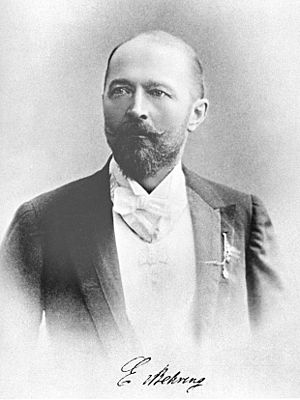Emil Adolf von Behring facts for kids
Quick facts for kids
Emil Adolf von Behring
|
|
|---|---|
 |
|
| Born | March 15, 1854 Hansdorf, Deutsch-Eylau
|
| Died | March 31, 1917 |
| Nationality | German |
| Alma mater | Army Medical College at Berlin Institute for Infectious Diseases |
| Known for | Research on diphtheria and tuberculosis |
| Awards | Nobel Prize in Physiology or Medicine (1901) |
| Scientific career | |
| Fields | Infectious disease |
Emil Adolf von Behring (born March 15, 1854, died March 31, 1917) was a famous German doctor. He is known for his amazing work on fighting diseases. In 1901, he won the very first Nobel Prize in Physiology or Medicine. He earned this prize for creating a special medicine called a serum that helped stop people from getting the serious disease called diphtheria.
Contents
Who Was Emil von Behring?
Emil von Behring was born in a small village called Hansdorf, which is now in Poland. He was one of 13 children! His father was a school teacher. Emil was a very smart student. He went to a special school for army doctors in Berlin. This school was called the Army Medical College.
After finishing his studies, Behring worked as a military doctor. He learned a lot about how diseases spread. This experience helped him later in his important research.
Fighting Diphtheria and Tetanus
In the late 1800s, diseases like diphtheria and tetanus were very dangerous. Many children died from diphtheria. It was a scary time for families. Doctors didn't have good ways to treat these illnesses.
Behring started working with other scientists, like Robert Koch. They studied how bacteria caused diseases. Behring focused on finding a way to fight the toxins (poisons) that these bacteria made inside the body.
The Diphtheria Serum
Behring discovered that if animals like horses were given small, safe amounts of diphtheria toxins, their bodies would create something to fight the poison. This "something" was later called an antitoxin. He found that this antitoxin could be taken from the animal's blood. It could then be used to treat sick people.
This special liquid from the blood was called a serum. In 1890, Behring and his colleague Shibasaburo Kitasato announced their discovery of the diphtheria antitoxin. This was a huge step forward in medicine.
The diphtheria serum was first used to treat children in 1891. It saved many lives. Before this, diphtheria was often a death sentence. Behring's work changed that.
Nobel Prize Winner
Because of his life-saving discovery, Emil von Behring was awarded the first-ever Nobel Prize in Physiology or Medicine in 1901. This prize recognized his incredible contribution to science and human health. He became known as "the savior of children" because his serum saved so many young lives.
Behring also did important research on tuberculosis. He tried to find a vaccine for this disease too. His work laid the groundwork for many future discoveries in immunology. Immunology is the study of how our bodies fight off diseases.
Images for kids
See also
 In Spanish: Emil Adolf von Behring para niños
In Spanish: Emil Adolf von Behring para niños


